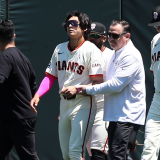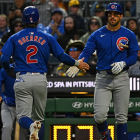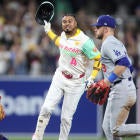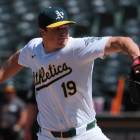These days it's impossible to watch a Major League Baseball game and not see a team employ the infield shift. They're everywhere. Some teams shift more than others, but nowadays everyday does it. The data tells clubs where certain players hit the ball, so they position their defenders accordingly. It makes perfect sense.
Many folks don't like the shift, so much so that there have been calls to ban it all together. Commissioner Rob Manfred even said he would consider it soon after taking office last year. I personally don't like the idea of banning the shift or limiting the ability to be creative on the field. Breaking balls weren't eliminated back in the day just because certain hitters couldn't hit them.
It may take some time -- as in years, not months -- for hitters to adjust to the shift, but it will happen eventually. This stuff is always cyclical. Right now though, there's an obvious benefit to having hitters in your lineup who can beat the shift by going the other way with regularity. It opens up more of the field and increases the odds of a base hit falling in.
The vast majority of infield shifts are used against left-handed hitters. Some righties see the shift regularly -- Edwin Encarnacion and Albert Pujols come to mind -- but it is predominantly a defensive strategy used against lefties. So, for the purposes of this post, we're going to focus on left-handed batters only. There aren't too many righties who have to worry about beating the shift.
A total of 96 left-handed batters have at least 200 plate appearances this season. Here are the five who see the most shifts, per data recorded by Baseball Info Solutions.
| Total PA | PA with Shift | Shift% | |
| David Ortiz, Red Sox | 450 | 399 | 88.7% |
| Chris Davis, Orioles | 486 | 409 | 84.1% |
| Ryan Howard, Phillies | 271 | 211 | 77.9% |
| Mitch Moreland, Rangers | 365 | 276 | 75.6% |
| Pedro Alvarez, Orioles | 277 | 209 | 75.5% |
Seventeen other left-handed hitters have been shifted in at least two-thirds of their plate appearances this years. Among those names are Brian McCann, Brandon Moss, Jay Bruce, Adam Lind, and Prince Fielder. These guys are all similar; they're big lumbering lefty bats who don't run well and do the most damage when they pull the ball. That's why they get shifted.
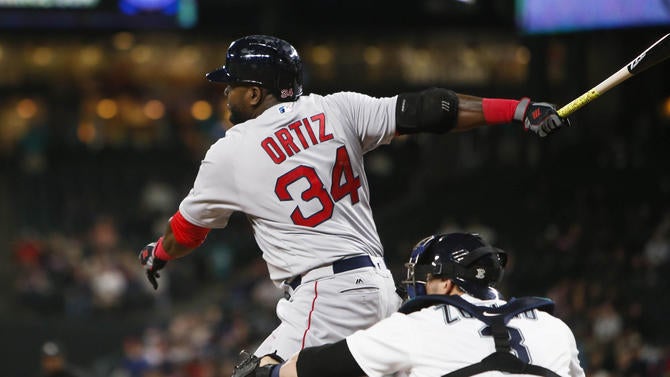
On the other side of the coin, among those 96 lefties with at 200 plate appearances, no one sees fewer shifts than Norichika Aoki of the Mariners. He's seen one shift (one!) in 349 plate appearances. That works out to 0.2 percent of his plate appearances. Fellow lefty speedsters Billy Hamilton, Ben Revere, Travis Jankowski, Adam Eaton, and Brett Gardner have all seen the shift in no more than five percent of their plate appearances.
Okay, so now that we know who's have seen the highest percentage of shifts this season, let's look at the left-handed hitters who hit the ball to the opposite field most often. Again, we're limiting ourselves to those 96 lefties with at least 200 plate appearances. The MLB average opposite field rate is 25.8 percent.
| Opposite% | Middle% | Pull% | |
| Travis Jankowski, Padres | 39.0% | 36.0% | 25.0% |
| Adam Eaton, White Sox | 37.7% | 39.2% | 33.2% |
| Ender Inciarte, Braves | 36.8% | 33.6% | 29.6% |
| Odubel Herrera, Phillies | 36.5% | 38.2% | 25.3% |
| Joe Mauer, Twins | 36.2% | 34.4% | 29.3% |
Four speedy slap hitters -- I don't mean that in a negative way, those four guys aren't power hitters, so their game is put the ball in play and run like hell -- and Joe Mauer. Mauer is the opposite of a speed player, but he has has long been one of the best opposite field hitters in the game, and that continues to this day. Interestingly enough, only one other lefty hitter has gone to left field with at least one-third of his balls in play this year: Corey Dickerson of the Rays (35.8 percent).
Now, simply hitting the ball the other way as a left-handed hitter does not guarantee success. Inciarte, for example, is hitting .268/.327/.341 (83 OPS+) despite his opposite field tendencies. He's not exactly a major offensive threat. Going the other way will help beat the shift and avoid seeing it all together, but it doesn't automatically equal good numbers. A years ago when Mark Teixeira focused on going the other way to beat the shift, and all he did was hit weak fly balls to left field, so his numbers cratered.
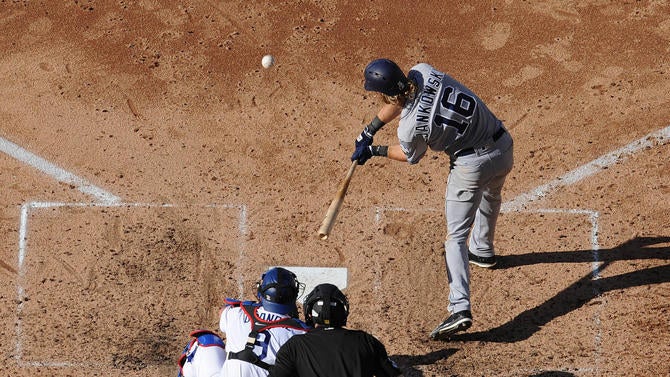
Hitting balls the other way is really hard! Some announcers seem to get irate over hitters' inability to go the other way at will, but if it were easy, everyone would do it. It's not necessarily the result of the hitter being stubborn. We're talking about changing a player's hitting approach and mechanics. That's not easy to do, especially if you're a veteran who has had success hitting one way for years and years.
So, with that in mind, here are the left-handed hitters who have been most productive when hitting the ball the other way. These guys are beating the shift and getting results. (Minimum 70 balls in play to the opposite field.)
| Opposite% | AVG | SLG | AVG+SLG | |
| Christian Yelich, Marlins | 28.3% | .538 | .791 | 1.329 |
| Carlos Gonzalez, Rockies | 26.2% | .547 | .756 | 1.303 |
| Joe Mauer, Twins | 36.2% | .475 | .775 | 1.250 |
| Adrian Gonzalez, Dodgers | 26.1% | .482 | .682 | 1.164 |
| Eric Hosmer, Royals | 31.9% | .450 | .712 | 1.162 |
Yelich has been the most productive opposite field hitter since he broke into the big leagues back in 2013, and this year the 24-year-old has learned how to maintain that opposite field approach while pulling the ball for power more often. That's why he's in the middle of a big breakout here. Yelich is becoming a complete hitter.
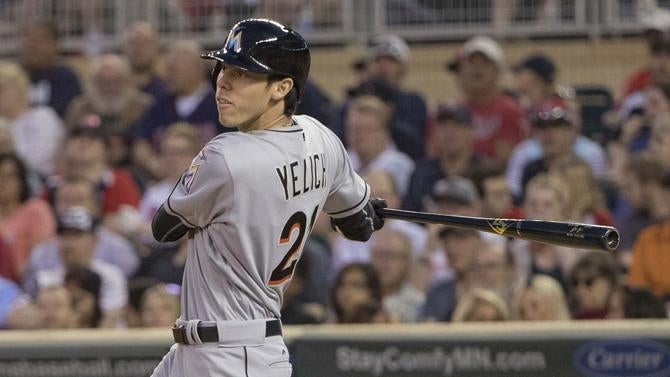
CarGo is a pretty interesting case study for the shift. The numbers say he's an extremely productive opposite hitter, but he's also one of the most shifted left-handed hitters in baseball. Opponents shift against Gonzalez in 70.0 percent of his plate appearances, so he wasn't too far away from making the very first table in this post.
So what gives? If Gonzalez is such a productive opposite field hitter, why does he get shifted so often? Check out his spray chart:
Source: FanGraphs
When CarGo puts the ball on the ground, he tends to pull it towards the right side of the infield, hence all the shifts. But when he puts the ball in the air, he tends to hit the ball towards left and center field. That's a unique profile.
Gonzalez sees the shift because he hits so many pulled grounders, yet he puts up such great opposite field numbers because he's hitting the ball over the fence the other way. There's no shift for that. It seems the best way to defend Gonzalez is by shifting your infielders to right side and shading your outfielders towards left field.
CarGo is unique. Others like Yelich, Mauer, and Hosmer make their living by being un-shift-able left-handed batters who go the other way with regularity. Those are the players who are most difficult to defend. It's not just about putting the ball in play to the opposite like, say, Inciarte. The most dangerous hitters are the ones who can go the other way and get big time results.







